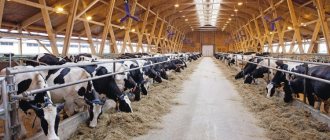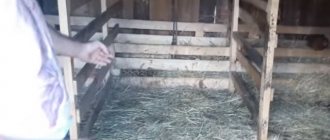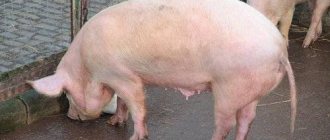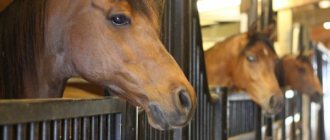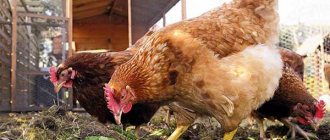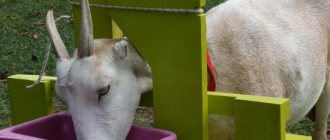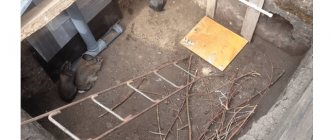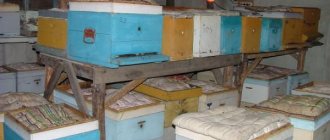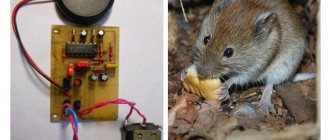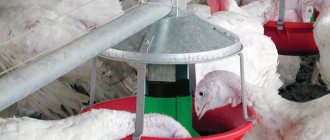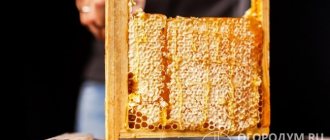Creating comfortable and proper conditions for keeping cows is an important factor affecting the health and productivity of animals. The construction of a cowshed should be carried out taking into account not only the number of livestock, but also the climatic conditions in the region, as well as hygiene standards and sanitary rules. When creating a barn with your own hands, you need to properly plan the internal and external space in order to provide space for all the animals and leave room for utility and utility rooms. From the article you will learn what to consider when designing a barn for home maintenance.
Calculation of the area and diagram of the barn by the number of heads
The size of the barn is determined by the number of livestock, the way the animals are kept, and the need for utility rooms. The approximate area of the barn with your own hands should be calculated depending on the number of heads. Initially, a drawing is created for a standard barn, on the basis of which a step-by-step design of the future layout begins in accordance with European standards for keeping animals.
During the planning stage, it is important to consider the use of every square meter in order to maximize the limited area.
The area of the barn directly depends on the volume of livestock, as well as the number of rows in the room. For small farms, the optimal area for 1 head is 10 m2, and for large farms it is about 6 m2. The stalls are always organized in a row manner. The maximum number of cows in one row is 50. The table shows the approximate dimensions of the barn for different numbers of cattle.
| Livestock | Area, m2 | Number of rows |
| 10 | 100 | 1 |
| 20 | 200 | 1 |
| 30 | 300 | 1 |
| 50 | 500 | 1-2 |
| 100 | 800 | 2-4 |
| 200 | 1200 | 6-8 |
| 300 | 1800 | 6-8 |
| 500 | 3000-4000 | 8-10 |
| 1000 | 6000-8000 | 8-10 |
Designing an area according to Euronorm dimensions
The barn is traditionally shaped like a rectangle or square, which increases the capacity of the building. The height of the room should be at least 2.2-2.5 m, but when using an attic the size increases. Each animal requires at least 6 m2, and a cow and calf require 12 m2. In practice, the pasture-stall housing method is most often used, so it is necessary to provide space in the barn for each cow. The average size of a barn is 100 m2; this area allows for the expansion of the animal population, as well as accommodating all the necessary outbuildings.
Demand and competition analysis
An important stage of the business plan is to study the market of consumer demand and supply of the closest competitors, their pricing policy and advantages.
The main threat to small businesses comes from large enterprises that manufacture products with long shelf life. They use expensive equipment to pack milk into special containers.
Therefore, farmers are forced to fight for the market with an emphasis on the quality of dairy products. But thanks to government support, private farming has gained a large market share and continues to develop.
What you need to consider to build a project
When choosing materials for barns, wooden boards or beams are most often used. The frame construction method is often used. All materials must be environmentally friendly, durable and cheap.
When constructing a barn, you should take into account the climatic conditions in the region, the budget, and the number of livestock. It is recommended to build a barn with a reserve, since in the future you need to be prepared for the appearance of calves.
Type of foundation for cows
The most profitable in terms of cost and functionality is considered to be a strip foundation, which is poured from concrete, less often with the addition of brick. This base allows you to subsequently install walls made of wood or even foam concrete. The foundation cushion should be sandy; it is advisable to provide a slope for future floors at this stage.
A strong and reliable foundation is important for long-term operation, as well as for keeping a large number of livestock. It is not recommended to use a wooden or columnar foundation if you plan to keep cattle for more than ten years - over time, the floor will begin to rot and there will be a risk that the large animal may fall through.
A wooden foundation is not durable, because... may rot over time.
The floor in a cow shed is made of wood, but it is better to use metal plates or concrete - they are not affected by moisture and will allow rodents to pass through.
Wall material
The materials used for the walls are wooden beams measuring 100x150 mm, foam concrete or brick. Frame walls have increased thermal protection and do not lose their properties for a long time. In addition, they are inexpensive and quickly erected.
When using timber, the wood must be treated with an antiseptic, and then plastered and whitewashed to avoid rotting and the accumulation of pathogenic bacteria. Foam blocks or sand-lime bricks are the second most popular materials for the walls of a barn due to their low cost, but when building a large room, it will take a lot of time and effort.
For large rooms, frame construction technology is often used.
Roof
For any outbuildings, a single-pitched or gable roof is used . Slate, roofing felt or corrugated sheets are used as roofing. In a barn, the second option is preferable, since the steep slope does not allow snow to accumulate and provides for the presence of an attic. The presence of a room under the roof performs several functions at once - it is used to store supplies of hay or straw, and it also serves as a kind of air cushion. A barn with an attic is always warmer, since there is additional thermal protection. The floor in the attic is made of boards fitted end to end, on top of which a layer of sand or sawdust is laid. The optimal height of the attic for storing bedding and feed is up to 1.9 m.
Sewerage: drawings
When keeping from 1 to 20 cows, sewerage is usually not done - animal waste products are regularly removed by hand, changing the bedding from hay and sawdust. However, with a large number of livestock, an automatic cleaning system is required. One option is to create a cesspool in which there is a trolley for manure. In each compartment for cows, a special gutter is made, connected to the general sewer system. Inside, scrapers moving in a cycle carry manure to a trolley, which moves waste products outside to a specially designated area. Such a system provides for the presence of rails, as well as a motor with a power of 5 kW.
There are a large number of drainage systems for barns. They work on a similar principle - the cow defecates directly in the stall, and then the manure that ends up in the general drain is removed from the premises in one way or another.
Ventilation for standard barns
The microclimate in the barn affects the health and productive qualities of animals. In cold conditions, cows spend a lot of energy heating their bodies, so milk production and weight gain are significantly reduced. In addition, cattle are exposed to drafts, in the presence of which they often get sick.
In regions with a dry and warm climate, the cold method of keeping animals is widespread. It is permissible to build a barn from two-layer or single-layer curtains, which are replaced with insect netting in the summer. This design affects not only the temperature in the barn, but also the level of light.
In cold areas, more reliable and durable structures are usually built, for example, from sandwich panels or wood. It is important to organize proper artificial ventilation. As a rule, this is a device made of polypropylene or metal pipes with valves, the outlet of which is located at the ridge of the roof. In summer, you can regulate the temperature in the room using windows. An artificial ventilation system is rarely used, since this is an additional cost for keeping animals.
One of the most important conditions for the proper maintenance of cattle.
Layout of feeding areas
Drinkers and feeders are an essential part. In a room containing at least two rows of stalls, the barn must be equipped with external feeders for livestock. Inside, the feeder stretches across the entire width of the stall, at an optimal height for the animal. The rear side, located closer to the passage, must be at least 75 cm in height, and the front - up to 35 cm. The width of the feeder is up to 40 cm, but the upper part can be slightly wider - up to 60 cm. The design has the shape of a pyramid, which is extremely convenient for feeding cattle in the barn, as well as for cleaning them from food debris. The bottom level should be at least 7 cm from the level of the stall bed. Automatic drinkers are placed above the feeder, usually in the far corner of the stall.
You can make a feeder yourself from wood, metal or clay, but it’s easier to buy a ready-made device that is equipped with all the necessary elements.
It is advisable to have small holes at the bottom of the feeder to drain water during washing. It is best to purchase separate designs for dry and wet food.
Segmentation into workshops (distance, rows)
Proper division of space in the barn allows you to optimize the work process and fully utilize the entire area of the room. Most of the room is devoted to stalls with a width of 1.1 meters and a length of up to 1.7 m. It is recommended to make short stalls to simplify the process of collecting manure and cleaning the premises. In addition, a passage between the rows should be equipped in order to have free access to the animal and the feeder. For single-row stalls, the row width is 1-1.2 meters. In addition, the following premises are required in a cow barn:
- walking area with canopy and side partitions;
- feed shed;
- attic;
- room for milking machines;
- workshop for slaughtering and storing carcasses;
- Evers designed cages for keeping calves;
- manure storage;
- compartments for storing root crops;
- utility rooms for tools.
The area of each subsidiary workshop is determined by the total area of the barn and the number of livestock. In addition, it is important to take into account the characteristics of the breed, since some types of cattle require a large walking area or increased stall space. It is important to take into account the type of productivity of your cattle; for the dairy sector, the workshop for milking machines and temporary storage of milk should be increased.
Read about how to build a stall for a cow with your own hands in this material.
Typical design of a barn for 200 heads.
Choosing a hangar type
The metal is lightweight and easy to use. When creating industrial facilities, it provides significant economic benefits and the shortest installation time. At the same time, facilities with proper arrangement and communications fully comply with the requirements for keeping cattle in favorable conditions.
The popularity of this type of hangar is not without reason:
- construction in the area of the month;
- the creation of a capital foundation is not necessary; support piles or a base in the form of a tape are often sufficient;
- the design is airtight and retains heat well (if it is insulated);
- no welding work, as is the case with frame hangars, which makes construction cheaper and faster;
- Due to the shape of the hangar, most precipitation does not linger on it.
A frameless arched hangar can be easily assembled in a short time, from metal sheets, right on the construction site. The steel is formed to the required parameters and is actually assembled as a constructor using a seam connection.
Business plan (to build a good wooden or frame barn, costs for young animals, feed)
The cost of maintaining and raising cows for meat is determined by many parameters. This is the area of the territory, the number of livestock, materials for the construction of the barn and the costs of feeding and servicing the animals. At the beginning, significant costs will always be required, which will begin to pay off only after several calvings, since proceeds from the sale of dairy products can only partially cover the costs of maintaining cattle.
Read the business plan for cattle breeding here.
Costs for the workover device
Setting up a farm and purchasing the first livestock of animals and feed for them requires significant financial investments. The primary costs for organizing a cattle breeding business are:
- Land lease . The price directly depends on the area. In fertile areas with a mild climate, the cost of rent for farming needs is always higher. It is advisable to acquire the necessary space over time, which will significantly reduce costs. To raise 100 heads of livestock, at least 1 hectare of territory is required.
- Construction and equipment of a cowshed . This is one of the largest expenses at the beginning of production. It is profitable to build a shed on your own without hiring third-party workers. The cost of construction depends on the area of the barn and the automation of the process. Most often they resort to modern prefabricated standard barn layouts, where all the necessary communications are connected: water supply, electricity, sewerage, ventilation, etc.
- Purchase of animals . Initially, it is advisable to purchase several adult cows and bulls, as well as 10-12 heads of young animals. You should not immediately buy purebred and breeding animals, since most often they require special maintenance;
- Purchase of feed . It is purchased based on the number of livestock, the season of the year, and also taking into account the required feed. In summer, food costs are lower, since grazing is possible. In addition, you should immediately purchase all vitamins and feed additives;
- Hiring workers and paying wages . Self-maintenance of a farm with more than 15 cows is physically impossible. Therefore, it is necessary to hire employees to clean the premises, care for animals and collect products. The cost of veterinary care must also be included in the estimate.
Read about the feeding diet for dairy cows here.
The costs of setting up a business vary greatly depending on the location. In the southern and eastern regions, raising cows is cheaper, but it is important to understand that there is more competition in the market in these areas.
Profitability
Raising cattle is a profitable business, but this condition applies only to large farms with established sales channels. In the early stages, you will need to invest at least 1 million rubles for the arrangement of premises, the purchase of animals and feed. On average, the farm's payback period occurs no earlier than in 1.5-2 years, provided that meat and milk are constantly sold and new animals are purchased. Profitability largely depends on the productivity and health of livestock. If you create the right conditions, you can subsequently receive a stable income from the sale of replacement young stock, especially when raising productive breeds of cattle.
Read about keeping a cow on a private farm here.
Let's sum it up
A barn for 100 heads is a large-scale structure that will accommodate not only a room for housing cows filled with stalls, but also additional areas in which materials for feeding animals will be stored, providing heat in the barn, etc.
Each cow indoors has its own place - a stall equipped with soft bedding, a feeder and a drinker.
The construction of such a farm can take a lot of money, however, you must remember that all your current costs will definitely pay off over time. You will have to wait about a year and a half, at the end of which your business will finally become profitable.
Video - Construction of a farm for cattle
Nikolay Zhuravlev chief editor
Author of publication November 12, 2018
Did you like the article? Save so you don't lose!
A cowshed designed to hold 100 cattle is considered large, and such buildings are not erected on private farms. However, such a project cannot be called unpopular, since recently more and more private farms are engaged in keeping and breeding cattle to produce meat and dairy products.
When planning the construction of such a barn, you need to take into account many nuances, starting from the features of the building itself and ending with its internal arrangement. The comfort of living and productivity of animals in the future will depend on the correct planning, construction and arrangement of the building. You can find theoretical and practical information on the design of a 100-head barn in our article today.
Conclusion: what is a modern ready-made barn (farm) for livestock
- When building a barn, you need to take into account the volume of livestock, whether free-tethering or tethering is planned, as well as the climatic conditions in the region. On average, one animal requires up to 6 m2, for cows with calves – up to 12 m2.
- The cow barn is built from cheap and environmentally friendly materials. Most often, it is wood, brick or foam concrete. Slate or corrugated sheeting is used as roofing material.
- The barn should be clean, warm and well ventilated. To do this, it is necessary to create a ventilation system and consider the features of thermal protection in the room.
- The division into workshops and the distance must be planned at the stage of creating the project. It is advisable to make the most of every meter of space, but at the same time comply with all sanitary standards.
- Raising cows as a business is a profitable business, but it requires significant initial costs for purchasing equipment, setting up a farm and purchasing livestock.
Read about how to make a pigsty with your own hands in this article.
Where to start building a barn
The construction of such a large premises for keeping cattle requires a preliminary drawing up of a plan for future work.
So, first of all, the site on which the barn will be built is determined. For this purpose, it is best to choose not completely empty land located far from civilization, but a site with an existing construction project, the use of which will allow you to avoid creating the building frame from scratch.
Then comes the turn of preparing documentation for the project being created. It specifies points such as:
- building materials used;
- type of building being constructed;
- technological features of the structure;
- equipment required for installation, etc.
Financial plan
The payback period for investments after opening a farm for fattening bulls is about 2 years. Its duration is influenced by many factors:
- initial investment volume;
- the presence of a land plot owned by the investor;
- percentage of loss of young animals during fattening.
Fattening bulls for meat will be a successful business if you correctly calculate the amount of investments and current expenses and try not to go beyond these limits.
Investments in the project
Let's consider how much money it will take to open a small farm in the countryside:
- purchase of a small plot of land – 30,000;
- construction of a corral - 130,000;
- purchase of equipment – 100,000;
- purchase of 20 calves – 250,000.
The total investment amount is 510,000 rubles.
Current expenses
Monthly expenses include:
- expenses for feed for calves – 30,000;
- salary for two employees – 30,000;
- other expenses – 5,000.
Total: 65,000 rubles per month.
Calculation of profit and payback period of the project
Bulls are fattened until they are 14–16 months old, that is, for a year after purchase. Further keeping of animals is inappropriate. For 10 months of fattening, the farm owner will spend 650 thousand rubles. At the time of slaughter, the weight of the bull is 700 kg. Wholesale buyers offer 90–100 rubles for 1 kg of beef. Considering that the slaughter yield of meat from a carcass is 65%, the farmer will earn about 50 thousand rubles from the sale of each of them.
A livestock of 20 bull calves, under favorable circumstances, will bring the entrepreneur 1 million rubles a year after opening the farm . Investments in the project will fully pay off after 2 years of work.
Breeding bulls for meat is a profitable business. Its advantage is that you can start with a minimum amount of investment, buying 2-3 calves, or with a large capital. For those who live in the village and are familiar with the specifics of cattle breeding, this is a great idea with prospects for expansion.
Purchasing cows or calves
Another significant cost item is the purchase of dairy cows or grown heifers. Their cost varies: a cow with 2-3 calvings costs from 70 thousand rubles , and a three-month-old heifer that needs to be raised costs 15-20 thousand rubles . If you buy young stock, the profit will be delayed by a year.
You need to purchase dairy breeds, the best of which are considered to be: Kholmogory, Holstein, Dutch, and Black-and-White. Their representatives are famous for their high milk yield and quality of milk. By purchasing elite breeds, you will get highly productive calves in the future. Which will serve as a source of additional income from breeding and selling them.
Registration of activities
Those who keep several bulls do not have to register their business activities. As the livestock increases, the issue of paperwork will still have to be resolved. By contacting the tax service, you need to write an application to open an individual entrepreneur and choose a simplified taxation system with a deduction rate of 6%.
Attention! In addition to registering the activity, you will have to obtain a license and certificates confirming the quality of the meat. Without these documents, it is impossible to sell finished products in large volumes.
Hiring
Next, you need to resolve the issue with the farm staff, the number of which will depend on the volume of the enterprise. If you have a KFC, then the number of employees will include family members.
If your farm is medium-sized, then at first you will need at least two milkmaids and two workers . When production is automated, they will work in shifts. Organizational functions and accounting at the initial stage can be carried out by the entrepreneur.
In the future, the staff will be expanded to include other job units: manager, marketer, driver, and support workers. You cannot do without veterinarian services such as the prevention and treatment of diseases of the udder, reproductive system, and hooves. The cost of annual veterinary care will be 100 thousand rubles .
Manufacturing of structures
As a rule, the designs of trusses made of metal are selected depending on the designed angle of inclination of their upper chord, the width of the overlapped span and the purpose
If we take into account the floors of industrial buildings, bridges and overpasses, where they are most often used, then for this purpose construction trusses are manufactured with a standard length of 12, 18, and 24 m/p
General requirements
For heavier and more critical structures (bridges and overpasses), I-beams and channels are used. All hydraulic structures are assembled from round elements or profile pipes.
Most often, a reinforced rolled angle is used to assemble standard construction trusses. In this case, for the manufacture of all its elements, a paired corner is used, the blanks of which are connected to each other by welding with special metal plates (fishes) inserted between them. The angles are paired in such a way that their cross section resembles a T-section.
However, recently metal structures of this configuration have begun to be in less demand due to the complexity of assembly, welding and painting. Steel profile or round pipes are increasingly becoming an alternative to such structures.
Correct calculation
It is necessary to understand that it is possible to make a high-quality calculation of the load-bearing device only if you have special knowledge, taking into account the requirements of SNiP and many other numerous factors. In order to correctly make calculations, designers use special programs.
When calculating the design of an engineering device, all the obtained values must be included in the design drawing, without which assembly of the structure will be almost impossible.
Initially, before drawing up a drawing project, a diagram of the truss is prepared indicating the main dependence of the slope of the upper chord and the total length of the future product
Factors such as:
- The contour of the supporting surface for the installation of a future roof or ceiling. This will help to calculate the angle of inclination of the upper belt of the supporting device.
- Saving material for the manufacture of the structure (unless the customer’s requirement is contrary to this saving).
- Correct calculation taking into account the maximum load expected for this product. It should be remembered that the angles of the braces in one design may be different, but the width of the panels should always remain the same for all.
- The distance between the fastening units is calculated last, but usually it is selected according to the width of the panel.
Once the main parameters have been calculated, you should decide on the design diagram. It is best to use special programs for this, which can be freely found on the Internet. For example, you can use the Truss Calculation program.
